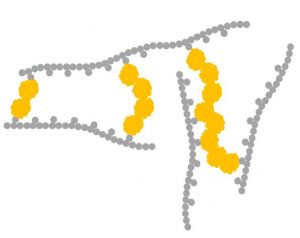Enhancing the stability of biomass-processing enzymes
We are investigating the basis of (thermo)stability in bacterial biomass-processing enzymes, and will use this information to engineer stability into enzymes of interest in the wood biorefinery.
Cross-linked protein-carbohydrate hydrogels

Using newly discovered carbohydrate-binding proteins, we are developing a novel method for hydrogel formation via biopolymer cross-linking.
Wood cell walls on the nano level
The aim of the project is to obtain information about the nanoscale distribution of the constituents in wood cell walls, such as cellulose, hemicellulose, and lignin. To reach our aim we will use a novel infrared microscopy technique (nano FTIR microscopy) with the unique ability to provide chemical information with a spatial resolution of 20 […]
Self-assembly of 2D nanoflakes by using 1D cellulose nanofibrils
The earth-abundant 1D cellulose nanofibrils (CNFs) have shown the capacity to assemble different functional nanoparticles into 2D films and 3D foams. 2D nanomaterials such as MXene, graphene, transitional metal dichalcogenides (MoS2, WS2, etc.) are the ones of most promising functional materials in optical, electronic, and magnetic fields. We are using the 1D CNF to align […]
Renewable High-Performance Materials from the Forest with Designed Degradation – Next Generation of Plastic (Re-Design Plastic)
Sustainable material design can alleviate the environmental burden related to material waste. Use of available and abundant resources, create materials that can be recycled, and final degradability in nature is central to achieve this. The overarching aim of the proposal is to holistically design new materials from cellulose fibers by; developing new sustainable modification strategies, […]
Development of biobased and recyclable composite materials
We aim to develop new renewable and recyclable materials generated from bioderived sources. Our particular interest is directed towards development of composite materials based on nanofibrilated cellulose and epoxy thermosets.
Large-scale extrusion of protein superabsorbents with cellulose fibres for hygiene applications
The project focus on producing sustainable superabsorbents (SAP) by utilizing fully integrated natural-based and biodegradable raw materials, combined with highly scalable polymer processing techniques. Extrusion of proteins combined with cellulose fibres, as a hygroscopic carrier for a water in-situ foaming process, is going to be implemented. The addition of blowing agents and reagents are going […]
Functional materials derived from wood and CNF
Functional composite materials derived from wood or CNF and studying their structure property relationship for energy harvesting, sensing and other applications.
New materials from Lignin
The goal of my project is creating new materials deriving from Lignin, in order to substitute materials deriving from petroleum.
Cellulose fibre/fibre interactions within molded fibre composites
This project aims to model cellulose fibre/fibre interactions using assembled CNF filaments produced by co-axial extrusion. These long, uniform filaments provide an excellent platform to investigate the impact of chemical and physical modification on joint strength. The findings of this work can then be used to a develop a better understanding of the interactions within […]
Expandable cellulose-based capsules
The development of expandable capsules holds a great promise for various advanced engineering applications. Preparation of such materials using renewable and sustainable resources is particularly attractive, where the development is driven by an increased global interest in new generations of green products that can meet the demands of the modern society. The aim of this […]
New specific chemical modifications for fibre functionalization including topo-selective modifications and advanced structure and chemical characterization
Identify robust modification strategies that unfolds a new generation of deliginified wet wood fibres with customizable properties. The scientific question that need to be addressed is strongly coupled to the apparent pore size of deliginified wet wood fibres and thereof the diffusion aspects of molecular/macromolecular/nanoparticle probes to homogenously bind to the exterior and interior of […]

